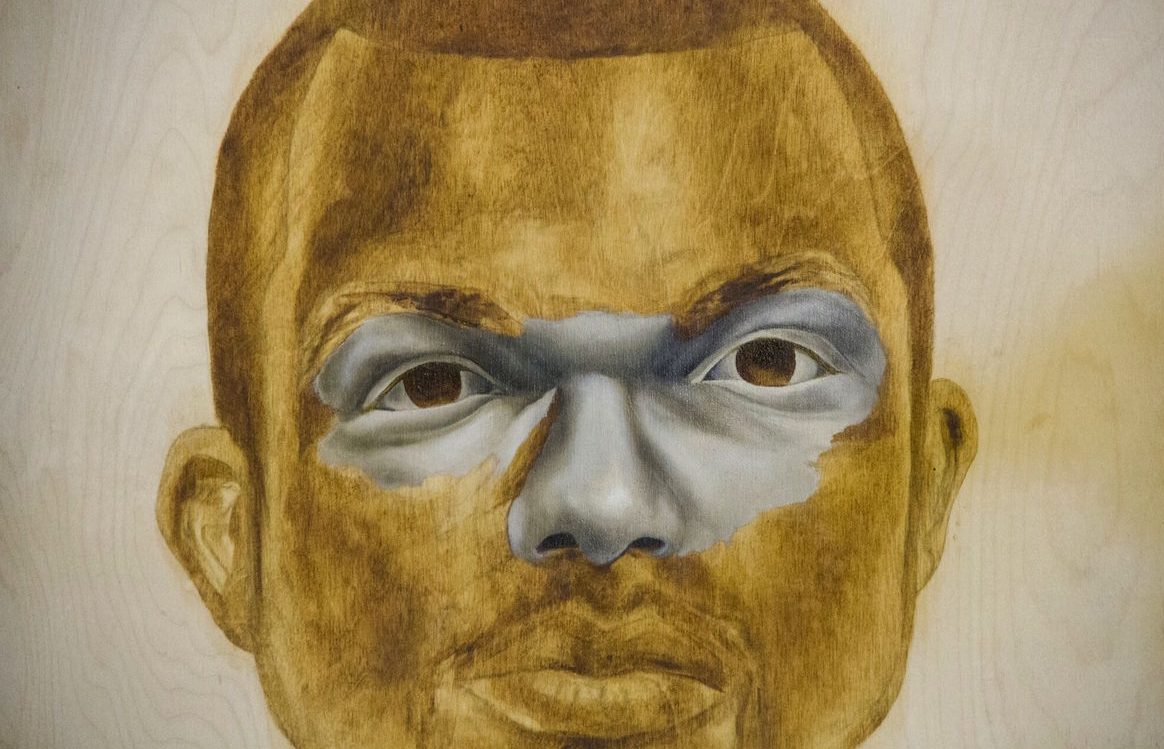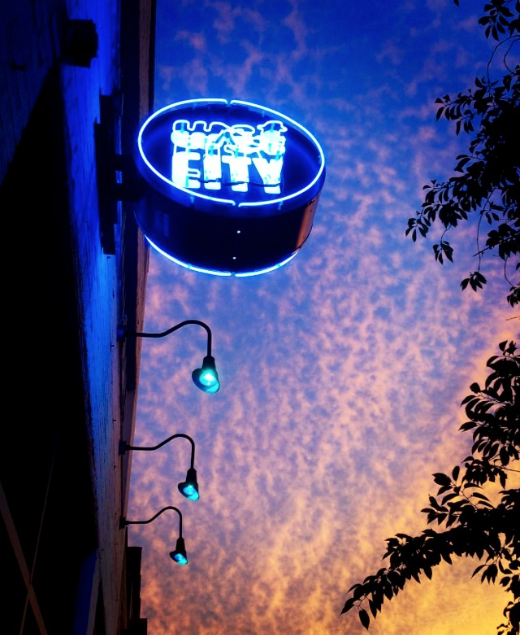Strange Landscapes at The Arlington Arts Center: Conversation and Critique with Curators Blair Murphy and Karyn Miller by Mike Dax Iacovone
Co-curators Blair Murphy and Karyn Miller of Strange Landscapes have assembled an impressive show full of artists pushing the genre of landscape into nontraditional directions. “Strange” would be the first hint, but that doesn’t do justice to the wide range of work in this show.
These two curators dismantle the ideology of landscape and employ it contemporaneously to include a far more interesting realm. Even the most traditional examples in the show, like paintings by Matthew Mann or Kate Stewart, offer examples the artist’s interest in subverting landscapes into something unfamilliar.
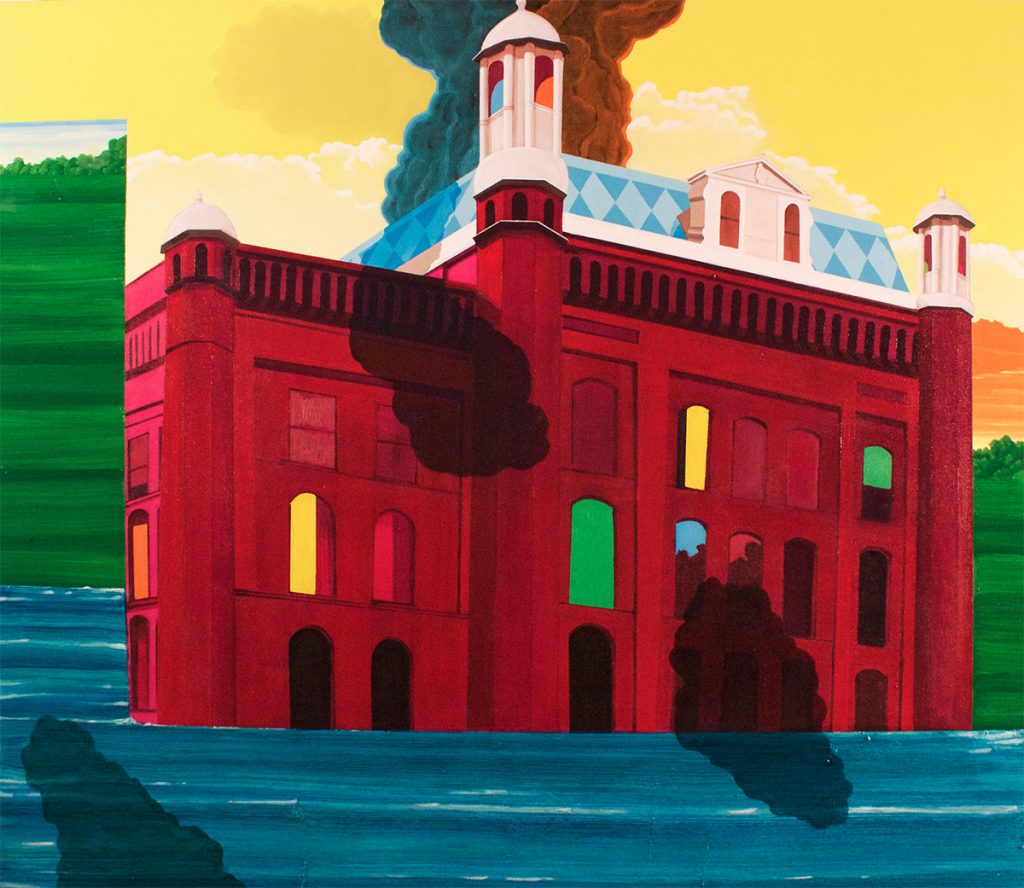
Matthew Mann “The Cluss Goose”
In Mann’s case, he supplants buildings lifted from urban landscapes into his own brand of misleading serenity. There is a tension between the buildings and the landscape; roles of protagonist and antagonist are shared by the buildings and the settings. Kate Stewart’s paintings depict a struggle between escape from a landscape or being consumed by it; either way it feels like an active struggle with the sublime while climbing out of, or falling into, a great hole.
“Samsies Island” (pictured at top) is an installation by Jaimes Mayhew that features a fictionalized utopian island for transgender men. The center of the room is filled with an inflatable “Wave of Mutilation” (heartwarming Pixies reference) which brings them to the island. The island’s shape references the male seahorse’s role reversal of carrying the fertilized eggs. There are postcards on on shelves that give hints of life on the island in wish-you-were-here notes that the viewers can read, and a hand-drawn map of the island is bursting with details of historic references and inside jokes.
The installation unfolds itself like a pop-up book, and succeeds at overriding the context of the room in an art gallery, allowing the viewer access to the fantasy. It was only well after I went through the piece that I processed what I think is the underlying point, that this island is a place for transgendered men to be comfortable, and to be themselves.
I really like this as an installation, but also as a fantastical storytelling device, a “Where the Wild Things Are” for the transgendered. “Wave of Mutilation” warmly invites people in, and the postcards turn the viewers into voyeurs, inviting them to read someone else’s mail.
Question for the curators: Do you see this functioning as one installation with multiple parts or as separate pieces? Also, he playfulness of this piece is so comfortable that it could possibly override what is a fairly sensitive subject – that transmen are looking for a place where they can be themselves. Do you think that the playfulness interferes with that at all?
Karyn Miller – I see it as one installation with several components. Jaimes originally showed the wave outside at Artscape. Bringing it inside gave the artist the opportunity to think through the project as an installation and to let it grow and develop.
The playfulness of the project doesn’t undermine the seriousness, but rather makes it more accessible and maybe a little easier for people to have a conversation about really critical social issues. It underscores the importance of the issues Jaimes is talking about — we aren’t giving certain members of our society access to the same level of health care, safe restrooms, housing, etc — so he’s imagined an island where transmen can have access to the things they need and want.
Blair Murphy – I agree with Karyn that the playfulness, hopefully, allows audiences to enter into a conversation about a sensitive topic. Ultimately, the project deals with the difficulties facing transpeople: the difficulty accessing resources, the violence they often face simply for being trans. But I think it’s also about community and how individuals who are disenfranchised or excluded build their own spaces and their own networks of support.
So the project is about the threat and dangers faced by trans people, but is also a celebration of the way individuals band together, both to fight for their rights in a more political sense, but also to create communities and chosen families. The map is a collaborative project and the postcards are sourced from Jaimes’ friends, so the project represents that kind of shared world-building even in its process.
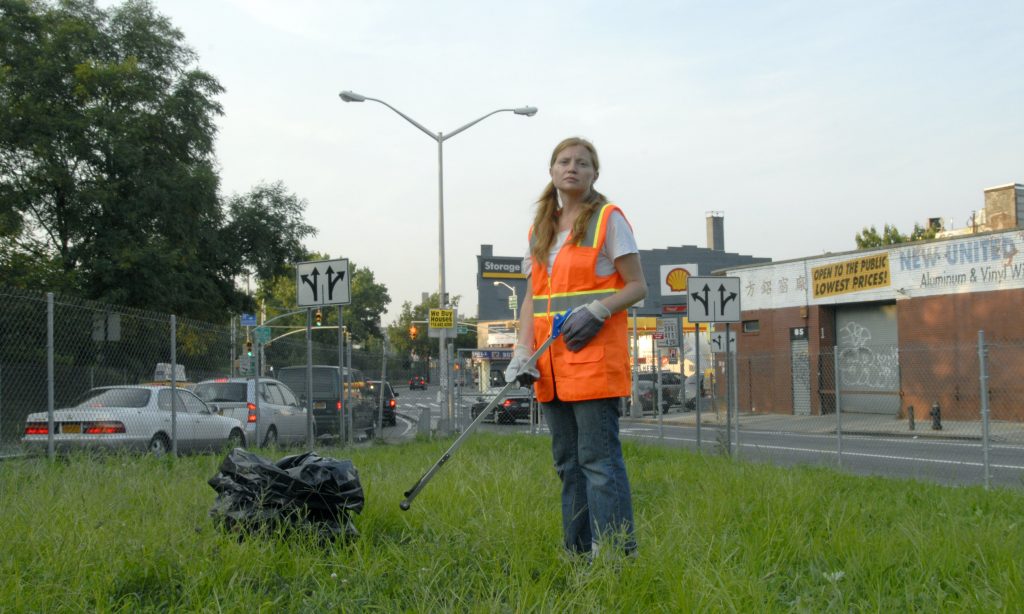 Katerina Jerinic “A Sculpture Made By My Efforts”
Katerina Jerinic “A Sculpture Made By My Efforts”
Katerina Jerinic became the caretaker of a parcel of land off the Brooklyn-Queens Expressway via the Adopt-a-Highway program and documented her interactions with the space featuring photos, video, and government forms on clipboards.
This is one of my favorite parts of the show. It’s reminiscent of Gordon Matta Clark’s “Fake Estates” project where he bought little bits of land in NYC that had no use or function, and documented the spaces (but ultimately died before he really finished working on them). It seems like she built a relationship with this land that was essentially useless, and became the caretaker of this non-place for a few years even though it probably went almost entirely unnoticed. I like how the work points out a space like that and the Sisyphean tasks of her intervention.
Do you think this might get the viewers to look at or pay attention to the in between spaces? This work can either point out the beauty of the task itself, or I think it could also be a distopic critique of city planning. Maybe it’s both?
Karyn Miller – Of course *you* love this project. I didn’t know about Matta Clark’s “Fake Estates” Project, but I adore his work and this particular project is brilliant.
Katerina’s project is so layered — her seemingly endless labors function as a parable for everyday life, it taps into gender issues, functions as an earthwork, comments on the bureaucracy of public space, leverages community engagement and participation, considers our relationship to nature and urban spaces, and, and… The reference to the 70’s era Earthworks is interesting, especially because they were mostly made by New York artists who fled the urban confinement to use the wide open west as their context to respond to. Jerinic brings that mode back to the urban, and recontextualizes it.
Blair Murphy – Yes! Katarina and I talked about the “Fake Estates” project during one of our studio visits, so I know it’s something she has thought about it. When she first told me about the project, I was imagining that it was more about her interactions with this big bureaucracy. But the Adopt-a-Highway program is really pretty loosely administered – it’s really less about some big, bad bureaucracy and more about this overlooked space and her dedication to maintaining it, despite the Sisyphean nature of the task. In some ways, it’s also about the lack of imagination we bring to public space – or at least the lack of resources.
Katarina was in Europe recently (sorry, I forget exactly where) and she told me that, when she explained the project to people there, she had to start by explaining the Adopt-a-Highway program. There isn’t a comparable program, at least not where she was and the idea that the government asks people to volunteer to do these things was strange to people. I also love that, as Karyn points out, there are so many threads from this project that can be followed – art historical references, conversations about public space, analysis of gendered labor etc.
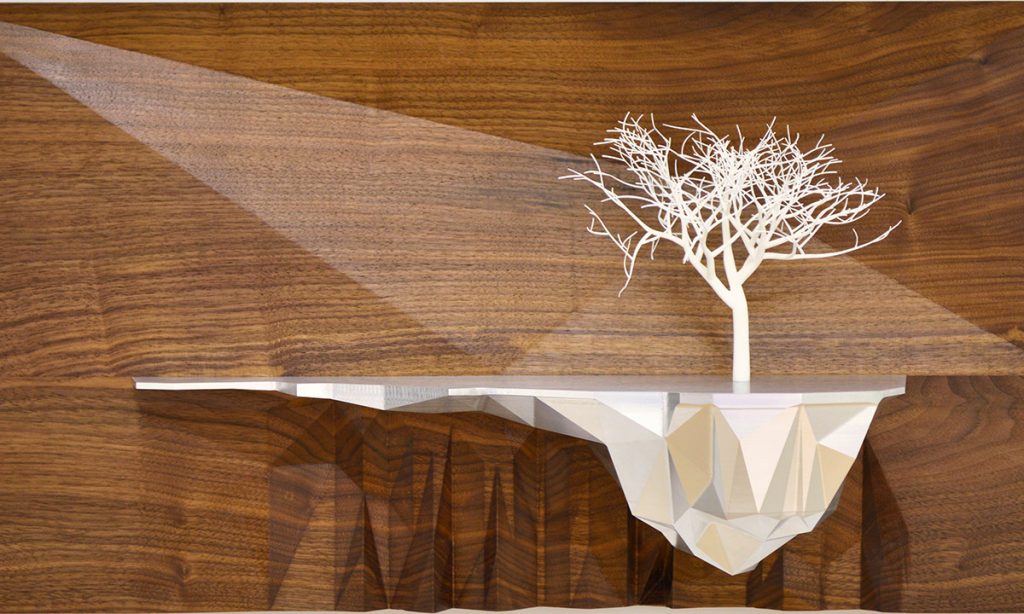 Ryan Hoover “Arborescent Algorithms”
Ryan Hoover “Arborescent Algorithms”
Ryan’s work is always clean, meticulously crafted, and attractive. Maybe it’s my inner-nerd thinking, but I think it might be a disservice to the viewer to not know about the algorithms he created that virtually grow those trees in a 3D program. Hoover studied nature and wrote code to simulate it. To me that’s even more interesting than what the work looks like.
As curators, you’re privy to his ideas, and this information, and anybody who asks will get this insight. But at what point is not having that info detrimental to the work? I know it’s not your job to explain everything to the viewers, but sometimes that helps, don’t you think?
Karyn Miller – It’s always hard to figure out the balance of how much information to give a viewer. The wall labels note that it’s 3D printed and we talk about the process in the catalog. I generally err on the side of not putting too much info on the wall, but making sure that information is available in the galleries. If you put too much text on a wall, viewers will spend the majority of the time reading the text and less time engaging with the work. But we could go round and round on this one!
Blair Murphy – This is a constant struggle with curating. I generally prefer not to have too much text directly on the wall. The information is in the catalog and the individual artist pages that are in the galleries. I agree that the algorithm is important, but I think the materiality of the work speaks to the tension between nature and technology. From there, hopefully viewers are intrigued enough to read more. But that’s always a challenging balance.
Fortunate Isles: Landings, 2016 – excerpt from Jacob Rivkin on Vimeo.
Jacob Rivkin’s “Fortunate Isles: Landings” video seems like it could be about life on a distant planet, or a critique of adapting to life on our rapidly changing planet. It’s ambiguous enough to toe the line between the two, yet it’s also about these specific creatures that seem to be trying to adapt to the strange landscapes and maybe they’re foraging for food. His far off locations, the Salt Flats in Utah and remote cliffs in Newfoundland, give the wide open sparseness that the Earth Art movement sought out in the 70’s and he inhabits it with lumbering creatures rendered in hand drawn animations.
I like the ambiguity the videos provide, and I think there are a lot ways to consider this work. How do you two interpret this work?
Karyn Miller – This work contains some elements of narrative cohesion — different characters navigating seemingly unfamiliar landscapes — but ultimately it resists that and is open-ended. Then there’s the really wonderful juxtapositions between the majesty and wonder of the landscapes depicted and this clumsy figure plodding along.
Blair Murphy – I definitely think that narrative is meant to be loose. It’s about the ability of these strange creatures to adapt to their surroundings, but I’m also interested in the ways it plays with representation of the landscape. The chroma-key process Jacob uses to insert the animation into the video is similar to the techniques that are used for CGI animation, but he intentionally uses the technique in a way that highlights the tension between the animation and the footage of the landscape.
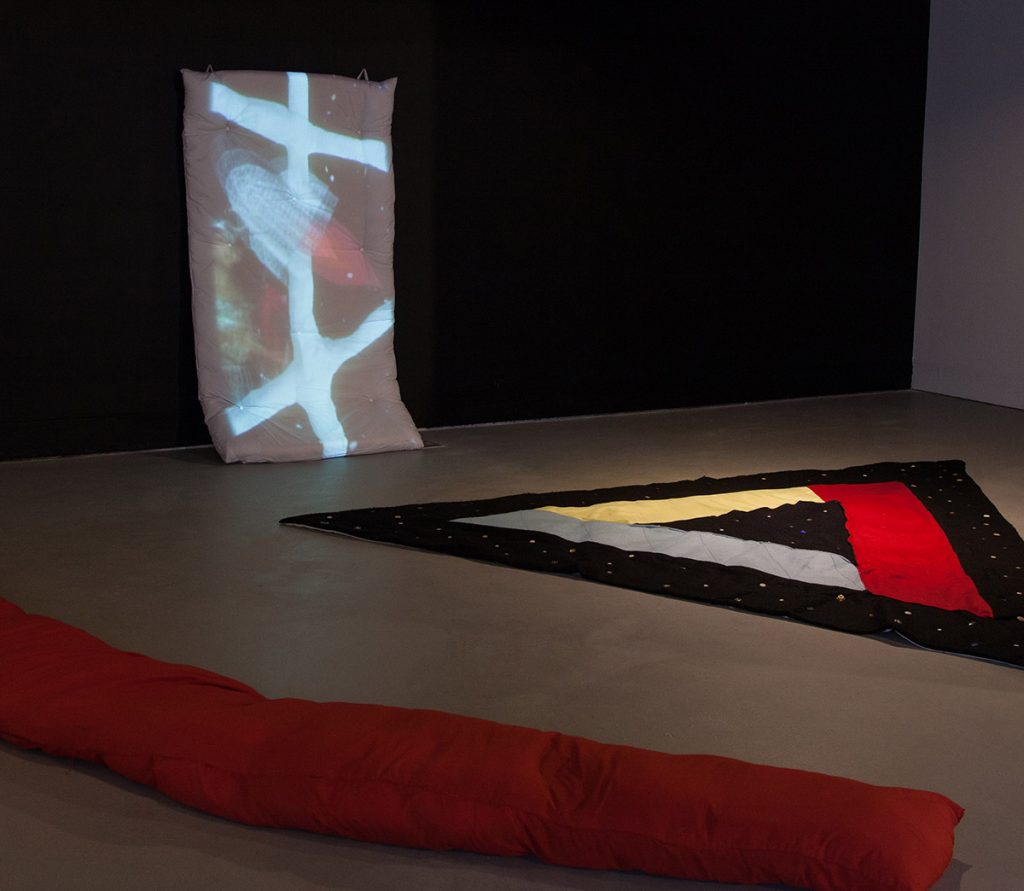 Ariel Jackson “B.A.M aka By Any Means Inc.”
Ariel Jackson “B.A.M aka By Any Means Inc.”
The video feels like an instructional guide to an experience, but I’m not sure what that experience is. It’s compelling to watch the video while the rest of the installation felt like a living room to view the video from. It was inviting enough to stay, but I was also trying to decode the installation. It seems to be as if they are artifacts from the video, or evidence of a situation the video was made for. How do you see the relationship between the video and the rest of the installation working out?
Karyn Miller – Ariel’s objects are an extension of the video and elements from the narrative enter into the viewer’s space to become part of the installation. It’s a way of engaging the body and making the viewer part of the narrative and not just a passive viewer. It implicates us and activates the space in a way that maybe just a screen wouldn’t.
Blair Murphy – The installation brings the video into the space (the specific forms of the installation are visible as illustrations in the video at some point) and also creates an environment for viewers to become drawn into the world of the video, to hopefully come a little closer and even sit down, rather than standing at a distance.
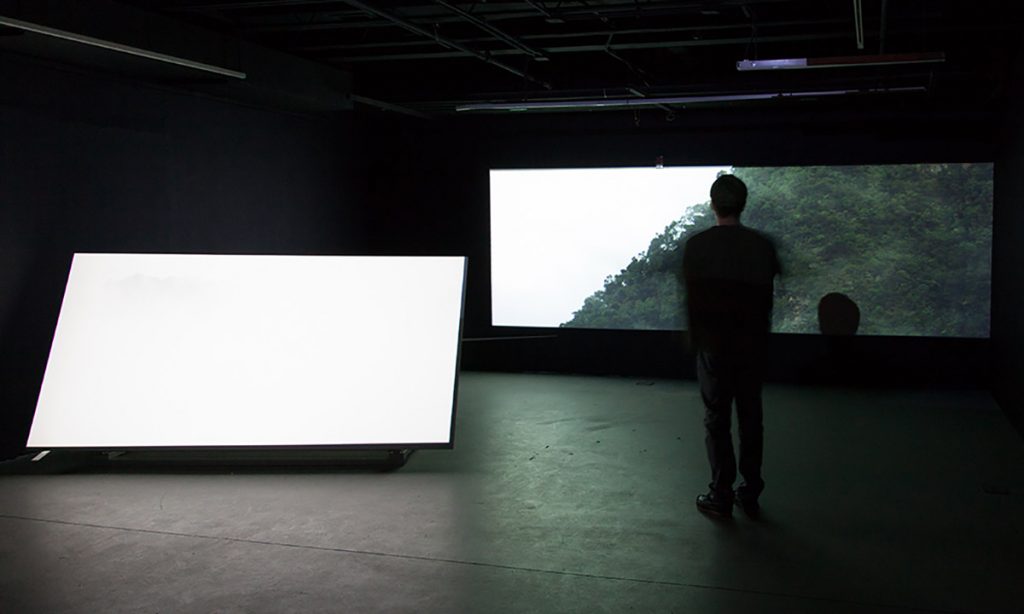
Margarita Sanchez Urdanita “Mouth Filled Ash”
The room for Margarita Sanchez Urdanita’s piece really does a good job of setting the stage for the atmosphere of the videos. The videos are so foggy and ephemeral they could be a dreamscape, but they also feel like they’re about loss and reconciliation. Can you explain what the artist had in mind?
Karyn Miller – Margarita is thinking very specifically about the ongoing political violence in Colombia. The Columbian landscapes depicted are fogged, frequently obscured, and are projected in tandem with bare, fractured texts — pulled from testimonies and accounts of Colombians impacted by the violence.
Blair Murphy – The work does have a connection to loss and reconciliation. As Karyn explained, Margarita’s work deals with the civil war in Colombia and, specifically, the way narratives about the violence are constructed and how those narratives impact the mourning process. The specific landscape in the video is the area surrounding the Magdalena River.
The river is known as a site where various sides in the civil war dispose of the bodies of their victims. The text in the video is pulled from journalistic accounts of violence and includes quotes from both perpetrators and the families of victims. The text offers one kind of testimony, the landscape images provide a visual account of the sites of some of the crimes, but both text and images offer an incomplete picture of the situation.
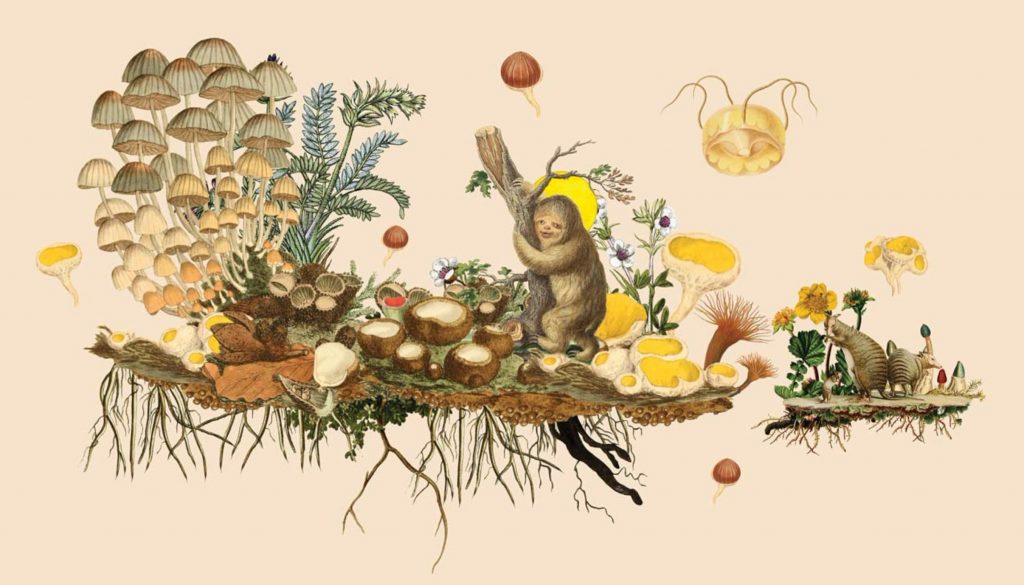 Edgar Endress “Santos” Series
Edgar Endress “Santos” Series
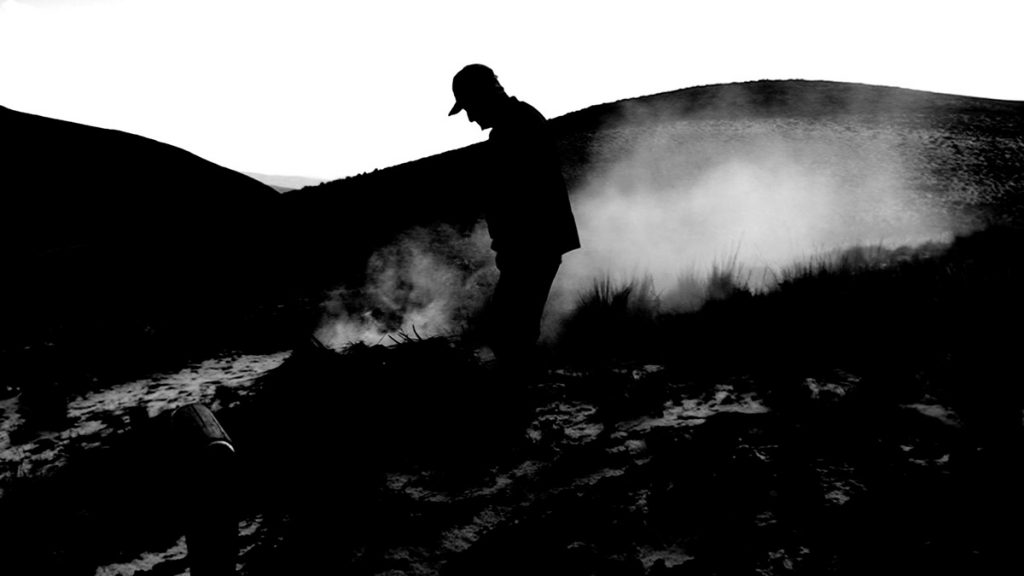
Edgar Endress video: “How to Make it Rain”
Edger Endres’s video is dreamy document about a very specific custom of climbing to the highest peak of a mountain and burning manure in a rain making ritual. I like how this ties into your Strange Landscapes theme as the video seems to comment on the futile task of man trying to intervene with the landscape in an effort to manipulate the weather for his own needs. Am I right about that? And can you explain his “Santos” series?
Karyn Miller – Both series play with this idea of landscape, power, and a pretty pervasive human desire to try and control our environment. The “Santos” series is based on 18th and 19th century botanical and zoological illustrations that were done of the Americas, North Africa, and other places to try and document, understand, and bring order to a “new” landscape. It also shaped and influenced the way that others understood these places.
Blair Murphy – With the “How to Make It Rain” video, it’s important to understand that the Quechua custom of burning manure to make it rain is a tradition that pre-dates colonialism. It’s an attempt to intervene into the landscape, but in a way that seems to integrate with, rather than fight against, nature. It seems like a couple times a year I read a curator’s quip about a show ‘redefining’ some end of painting, sculpture, or some other traditionally accepted art genre and yet those bold statements are seldom, if ever, lived up to.
Instead, what is often found in those shows might very well be good or even great work, but not a redefinition, or anything more than a homage to that which they were said to ‘redefine’.
Curators Murphy and Miller are not redefining ‘landscapes’ nor did they claim to, but what they do achieve is a richer understanding of what a landscape can be. What they did do is take a clear understanding of landscape, and the baggage that comes with it, the tension between setting and scale, between the viewer and their struggle with corporeality, and they utilized artists who address those issues head on. This is a great show.
*****
Author Michael Dax Iacovone is a DC based artist who works in photo, video, maps and installation.
Photos courtesy of the Arlington Art Center
Top Image: Jaimes Mayhew Wave of Mutilation
Strange Landscapes is on exhibit at the Arlington Arts Center through October 2, 2016.
